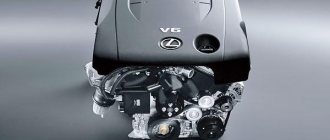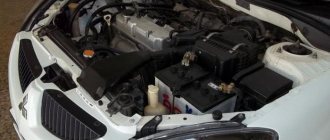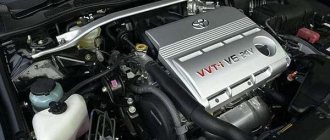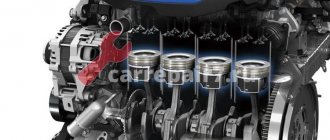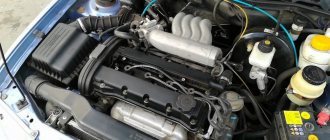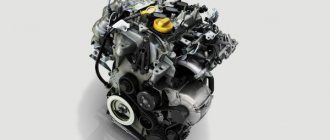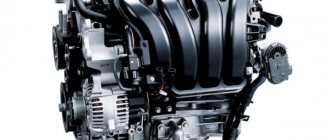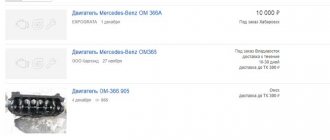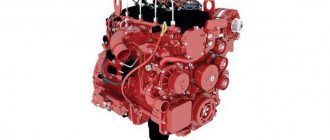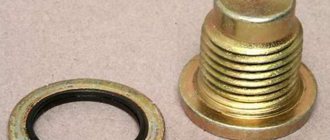Representative of environmentally friendly power plants, Toyota diesel 2.8 1GD-FTV began to be produced since 2015. The 2.8 liter engine is equipped in SUVs, pickups and minibuses. In terms of dynamics, the new internal combustion engine did not improve compared to its predecessors, but the developers managed to achieve reduction of noise and vibrations.
Below we will talk about the technical features of the engine, its characteristics and problem areas.
Characteristics of the 1GD-FTV engine
The technical characteristics of the 1GD series motor are as follows:
- exact volume – 2755 cubic meters. cm ;
- power (hp) – 177;
- torque (N/m) – 420-450;
- compression ratio - 15.6;
- lubricant change frequency – 10,000 km;
- engine oil - 7.5 l ;
- environmental class – Euro-6
- fuel used - diesel;
- power supply – common-rail direct fuel injection
- cast iron cylinder block;
- number of cylinders – 4;
- valves per cylinder – 4;
- piston stroke – 103.6 mm;
- cylinder diameter – 92-98 mm;
- Timing – chain;
- years of production – 2015 – present;
approximate resource – 250 thousand km .
Fuel consumption
Toyota Fortuner 2016
fuel consumption characteristics (using the example of the Toyota Fortuner 2021 with automatic transmission):
- city - 11 l ;
- highway - 7.3 l ;
- mixed version - 8.6 l .
Diesel consumption on other cars with 1GD-FTV:
- Land Cruiser Prado 150 with 6 automatic transmission and all-wheel drive - 9,2/6,3/7,4.
- Toyota Hilux Pick Up with 6 automatic transmission — 10,9/7,1/8,5.
Toyota Hilux Pick Up
1GR-FE
The four-liter gasoline engine 1GR-FE has been produced since 2002 in Japan and the USA. The motor is intended for large cars with rear-wheel drive and all-wheel drive. The power unit found its application under the hood of the all-wheel drive version of the Toyota Land Cruiser Prado, its power is 249 horsepower. Made of aluminum materials: both the cylinder block and the cylinder head are aluminum. The cylinder head in this engine is 24-valve, and the 1GR-FE V-shaped six-cylinder architecture. Peak torque reaches 377 Nm. The diameters are bored to 94 mm, and the piston travels to 95 mm. There is one VVT-I phase regulator installed here, but there is a modification of the engine with Dual VVT-i. The main problem that car owners most often have to deal with is related to overheating of the internal combustion engine. A critical increase in operating temperature often results in a breakdown of the cylinder head gasket with all the unpleasant consequences.
Do not be afraid of the increased noise of the motor - this is one of the features of its operation. Constantly accompanied chirping and clattering is normal. However, it is necessary to be able to correctly distinguish between normal and abnormal engine noise. Sometimes the VVT-I clutch cracks when starting the power unit. If the engine is running rough, then first of all you should check the ignition coils. A dirty throttle assembly results in floating idle speed. The water pump in this engine has a short lifespan. In general, the engine is quite good and is maintaining the 300 thousand kilometers required for the Japanese power unit. Also, do not forget about self-adjustment of thermal clearances, since hydraulic compensators are not provided in the 1GR-FE. If you operate this internal combustion engine correctly and do timely maintenance, the service life can exceed 500,000 kilometers.
Technical features of 1GD
The engine in question, labeled 1GD-FTV, maintains the traditions of the 1GD series, since the cast iron cylinder block is unlined. Series modifications for Hilux cars do not provide a balancing mechanism . It is used on internal combustion engine versions for Prado SUVs and Hiace light-duty trucks. The drive is carried out by a separate chain , the mechanism itself is located under the block.
Cylinder block 1GD-FTV
The full-length 1GD-FTV pistons are made of a lightweight metal alloy . Alloy cast iron insert located in the groove of the upper ring. The piston skirt has a polymer coating. Floating pins connect the pistons and connecting rods.
Piston 1GD-FTV
The material for the block head is an aluminum-based alloy . The injectors are vertical, the spark plugs are between the intake ports. The rockers are lubricated through channels made in the plastic cover above the 1GD-FTV head.
Cylinder head with two camshafts 1GD-FTV
Timing and lubrication system
The gas distribution mechanism (GRM) of the 1GD engine is represented by two shafts located in the cylinder head. There are four valves per cylinder (two for intake and two for exhaust). The car is equipped with hydraulic compensators and roller tappets , which simplifies maintenance in terms of valve adjustment.
From the crankshaft, the chain drives the fuel pump shaft, the secondary chain goes to the camshafts. The hydraulic tensioner is responsible for the tension . The vacuum pump is driven from the rear of the camshaft. The operation of the oil pump depends on the gear drive coming from the crankshaft.
Crankshaft 1GD-FTV
The liquid-type oil cooler is located in the frontal part of the engine. The cylinder block is equipped with oil nozzles that provide cooling and lubrication to the pistons.
Oil injectors 1GD-FTV
Inlet
The series of engines under consideration is equipped with turbochargers , and the guide vane (second generation) is capable of changing geometry . This ensures constant pressure maintenance regardless of the engine speed. At high speeds, back pressure is minimized, and at low speeds, power increases. There is no bypass mechanism on the 1GD-FTV. is provided with liquid cooling .
Turbocharger for 1GD-FTV engine
The air is cooled by 1GD-FTV front intercooler an electronic drive throttle valve Thanks to this, the noise when the engine is idling is reduced, and the engine stops smoothly when turned off. There are dampers in the tract that are responsible for changing the geometry (the pneumatic drive is responsible for their operation). Thanks to the design, a vortex is formed at the inlet, and the combustion process of the fuel-air mixture is improved.
Intercooler for 1GD-FTV engine
A little about the fuel system
In 1GD series engines, a high-pressure pump (abbreviated as injection pump) supplies fuel; fuel enters the cylinders through injectors . The latter are equipped with electronic control. Thanks to Common Rail, pressure can reach up to 220 MPa (this value can be considered a record). Consumables are supplied by Denso .
Injection pump for 1GD-FTV engine
During one piston operating cycle, injection occurs to top dead center (twice), at TDC (main), and on the expansion stroke (late). The fuel pressure is controlled by dosing the supply and thanks to the dump valve (drain dosing). Precise fuel supply control is ensured by an abundance of 1GD sensors installed in the system (there are more than ten , of different types).
Fuel injector 1GD-FTV
Disadvantages and weaknesses of 1GD
The Toyota engine marked 1GD-FTV did not show any serious problems during the first years of operation. Nevertheless, the engine has weak points.
The manufacturer listed typical faults in the service bulletin. This is about:
- Diesel particulate filter clogged . The reason is difficulties with auto-regeneration. The problem was solved by replacing the firmware and installing a forced regeneration button.
- Dust entering the intake manifold. As a result, power decreases and the on-board computer generates various errors. The Toyota concern did not recognize the fault, although it described it indirectly in the TSB bulletin .
- Breakage or destruction glow plugs. It is recommended to replace it, install new firmware, and in extreme situations, check the cameras for the presence of spark plug pieces.
Checking the glow plugs - Weak fastening of the fuel pipe between the pump and the ramp (on Prado, Hiace and Regius Ace vehicles assembled in Japan between March and June 2021). A recall company has been organized.
- Wear of camshafts and rockers . A characteristic symptom is instability of the 1GD-FTV internal combustion engine at idle. In 2021, two revisions of timing parts were carried out, which indicates a serious disadvantage in development.
Engine reviews, pros and cons
Judging by the reviews, car owners experience frequent leaks as a result of long-term operation of the engine without proper preventive maintenance. But here the owner himself is more likely to blame than the engine or the company installing the engine on the vehicle.
Increased diesel fuel consumption and an outdated viscous coupling negatively affect user reviews. The 3L engine may experience prolonged oil starvation due to the oil line being too long.
The second disadvantage that users highlight is the bursting of the combustion chamber. They do not fall out of the cylinder head. The car can travel another thousand kilometers with such a breakdown.
These motors are noisy. Too much vibration comes from them at idle. This is all also included in the negative assessment of car owners.
But the advantages largely cover the negative aspects of the power unit described above. Overheating in such 3L engines is almost impossible. There were even cases when a vehicle drove properly with a broken pump in the cooling system.
According to the manufacturer’s instructions, the timing belt does not break up to 100 thousand kilometers. However, according to experienced car owners, the engine will operate up to 150 thousand km with the same belt.
Attention! Experienced mechanics still advise looking at the belt after 60 thousand km. This is done to prevent the valves from bending.
Car owners approve of the fact that the engine is not tied to synthetics or mineral water. Both synthetic and mineral oils can be used. This will not harm the motor. It is only recommended to buy lubricants in specialized auto stores. Since a counterfeit lubricant can lead to failure of the power unit.
Similar article Technical characteristics of the Toyota 3U engine
The attachments are installed in such a way that they do not interfere with preventative maintenance of the engine. For this, experienced mechanics are grateful to Toyota.
The fuel filter is updated after a mileage of sixty thousand kilometers. And spark plugs are changed after 20 thousand km. The intake manifold also serves as a fuel filter. After 60 thousand km, the walls in it begin to burn out. Replacement to come.
On SUVs and pickups, it is necessary to clean the air filter devices once a year and change them after a mileage of 50 thousand km. For buses and trucks with this engine, it is recommended to clean the air filters twice a year.
The oil filter device is replaced after 10 thousand kilometers. And the engine oil itself is changed after a mileage of 5 thousand km. If the car is not used and has been sitting in the garage for a year, then it is better to replace the lubricant at the beginning of the car’s operation.
What cars was it installed on?
Land Cruiser Prado 150
The engine marked 1GD-FTV from the 1GD series was installed on the following cars:
- Land Cruiser Prado J150;
- Innova AN140;
- Fortuner AN160;
- Hilux AN120.
Innova AN140
